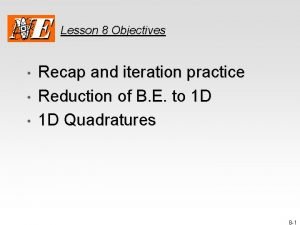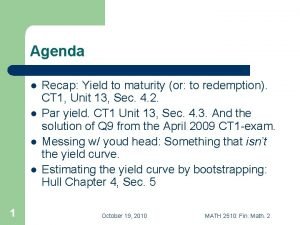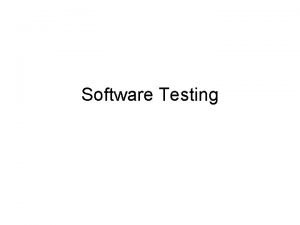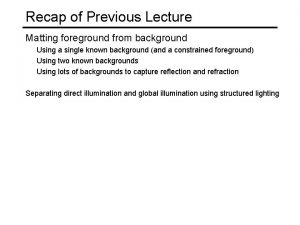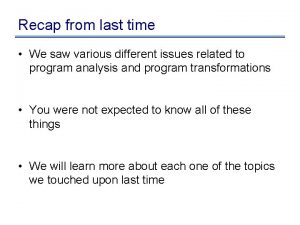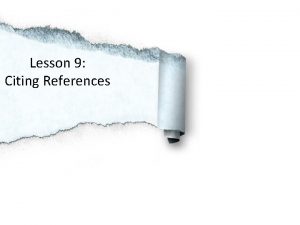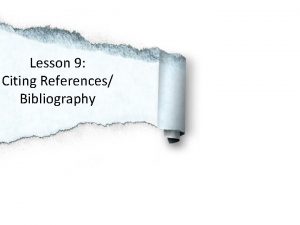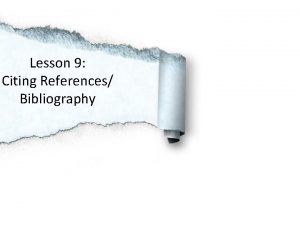Talkie Time and Recap 4 1 Lesson 4







































- Slides: 39

Talkie Time and Recap 4 -1

Lesson 4: The Human Body (An Orientation)

Learning Competencies: 1. Animals Process: The Introduction to Human Body STEM_BIO 11/12 - IVa-h-1 • Recall the Organ-system of the body • Identify the sections of the human body (Anatomical Description) • Demonstrate understanding of the sections (Anatomical Description)

Buzz Session: 1. Why should we be concerned in knowing the human body? 2. What is Anatomy? What is Physiology? What are its importance?

An Overview of Anatomy § Anatomy - The study of the structure of the human body § Physiology - The study of body function

An Overview of Anatomy § Anatomical terminology § Based on ancient Greek or Latin § Provides standard nomenclature worldwide § Branches of anatomy § Gross anatomy § Microscopic anatomy (histology) § Surface anatomy

The Hierarchy of Structural Organization § Chemical level – atoms form molecules § Protoplasmic Level - basis of Life with macromolecules § Cellular level – cells and their functional subunits § Tissue level – a group of cells performing a common function § Organ level – a discrete structure made up of more than one tissue § Organ system – organs working together for a common purpose § Organismal level – the result of all simpler levels working in unison

The Hierarchy of Structural Organization Figure 1. 1

Systemic v. Regional Anatomy § Systemic – study of anatomy by system § Regional – study of anatomy by region § Most students use a combination of regional and systemic study

The Integumentary System § Forms external body covering § Protects deeper tissues from injury § Synthesizes vitamin D § Site of cutaneous receptors § (pain, pressure, etc. ) and sweat and oil glands

The Skeletal System § Protects and supports body organs § Provides a framework for muscles § Blood cells formed within bones § Stores minerals

The Muscular System § Allows manipulation of § § environment Locomotion Facial expression Maintains posture Produces heat

The Nervous System § Fast-acting control system § Responds to internal and external changes

The Endocrine System § Glands secrete hormones that regulate § Growth § Reproduction § Nutrient use

The Cardiovascular System § Blood vessels transport blood § Carries oxygen and carbon dioxide § Also carries nutrients and wastes § Heart pumps blood through blood vessels Figure 1 -2(f)

The Lymphatic System § Picks up fluid leaked from blood vessels § Disposes of debris in the lymphatic system § Houses white blood cells (lymphocytes) § Mounts attack against foreign substances in the body

The Respiratory System § Keeps blood supplied with oxygen § Removes carbon dioxide § Gas exchange occurs through walls of air sacs in the lungs

The Digestive System § Breaks down food into absorbable units § Indigestible foodstuffs eliminated as feces

The Urinary System § Eliminates nitrogenous wastes § Regulates water, electrolyte, and acid-base balance

Reproductive System § § Overall function is to produce offspring Testes produce sperm and male sex hormones Ovaries produce eggs and female sex hormones Mammary glands produce milk Figure 1 -2(l)

Gross Anatomy – An Introduction § Anatomical position – a common visual reference point § Person stands erect with feet together and eyes forward § Palms face anteriorly with the thumbs pointed away from the body Figure 1. 3

Gross Anatomy – An Introduction Regional terms – names of specific body areas § Axial region – the main axis of the body § Appendicular region – the limbs § Directional terminology § Refers to the body in anatomical position § Standardized terms of directions are paired terms § Figure 1. 3

Orientation and Directional Terms Table 1. 1 (1 of 3)

Orientation and Directional Terms Table 1. 1 (2 of 3)

Orientation and Directional Terms Table 1. 1 (3 of 3)

Regional Terms Figure 1. 4 a

Regional Terms Figure 1. 4 b

Body Planes and Sections Coronal (frontal) plane - Lies vertically and divides body into anterior and posterior parts § Median (midsagittal) plane - Specific sagittal plane that lies vertically in the midline §

Body Planes and Sections § Transverse plane - runs horizontally and divides body into superior and inferior parts Figure 1. 5

Body Planes and Sections § Oblique section through the trunk Figure 1. 6

Body Cavities and Membranes § Dorsal body cavity § Cavity subdivided into the cranial cavity and the vertebral cavity. § Cranial cavity houses the brain. § Vertebral cavity runs through the vertebral column and encloses the spinal cord

Body Cavities and Membranes § Ventral body cavity – subdivided into: § Thoracic cavity – divided into three parts § Two lateral parts each containing a lung surrounded by a pleural cavity § Mediastinum – contains the heart surrounded by the pericardial sac

Body Cavities and Membranes § Ventral body cavity § Abdominopelvic cavity – divided into two parts § Abdominal cavity – contains the liver, stomach, kidneys, and other organs § Pelvic cavity – contains the bladder, some reproductive organs, and rectum

Body Cavities and Membranes § Serous cavities – a slit-like space lined by a serous membrane § Pleura, pericardium, and peritoneum § Parietal serosa – outer wall of the cavity § Visceral serosa covers the visceral organs

Body Cavities and Membranes

Other Body Cavities § § § Oral cavity Nasal cavity Orbital cavities Middle ear cavities Synovial cavities

Abdominal Regions and Quadrants § Abdominal regions divide the abdomen into nine regions

Abdominal Quadrants § Abdominal quadrants divide the abdomen into four quadrants § Right upper and left upper quadrants § Right lower and left lower quadrants

APPLICATION: Locate the following Anatomical DESCRIPTIONS
 Talkie time
Talkie time Windtalker walkie talkie
Windtalker walkie talkie Romeo and juliet recap
Romeo and juliet recap Start time, end time and elapsed time
Start time, end time and elapsed time The shawshank redemption analysis
The shawshank redemption analysis Short summary of the great gatsby
Short summary of the great gatsby Price is right recap
Price is right recap What is the purpose of an iteration recap?
What is the purpose of an iteration recap? Recap intensity clipping
Recap intensity clipping 60 minutes recap
60 minutes recap Recap database
Recap database Bracket power rule
Bracket power rule Recap introduction
Recap introduction Recap introduction
Recap introduction Recap from last week
Recap from last week Why does danforth refuse to postpone the hangings
Why does danforth refuse to postpone the hangings Pontius pilate allusion
Pontius pilate allusion Logbook recap example
Logbook recap example Ytm recap
Ytm recap Black box recap
Black box recap Fractions recap
Fractions recap Recap
Recap Quadrant in cartesian plane
Quadrant in cartesian plane Recap indexing scans
Recap indexing scans Lets have a recap
Lets have a recap Recap poster
Recap poster Public transportation essay
Public transportation essay Ldeq recap
Ldeq recap Recap accounting
Recap accounting Example of recap
Example of recap Let's recap
Let's recap Perfect lesson 7
Perfect lesson 7 Foil method for punnett squares
Foil method for punnett squares Recap background
Recap background Briefly summarise
Briefly summarise Saw recap
Saw recap Briefly recap
Briefly recap Micro planning in education
Micro planning in education Sat vocabulary lesson and practice lesson 4
Sat vocabulary lesson and practice lesson 4 The science duo physical and chemical changes
The science duo physical and chemical changes







